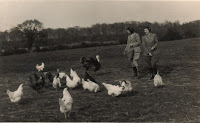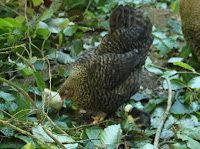When we started to think about creating a forest garden, from the canopy to the ground cover, my first thought was for roses. I love them and I always dreamed of creating a space that would be full of perfume, colour and fruit, so the old-fashioned pre-1950s and by no coincidence French roses, were the ones I sought. Ironically, in the 1990s, when we really started the major plantings, France was the last place they could be found. Again I had recourse, as with the hedging, to the trusty BMW tourer and again it is surprising how many bare rooted rose bushes you can strap onto the back of a motorbike. There is an accompanying film at the end of this article.
Creating The Carpentry For The Canopy
Twenty-five years ago a customs certificate was required to transport roses from the UK to France and so we arrived with a garden's worth of rose bushes. The basis of this was 'The Empress Joséphine Collection' from Peter Beales of Norfolk, who have an impressive range of ancient roses. Coals to Newcastle it might have been but France was still gripped in her own particular version of what I call Wheatcroft fever. The roses above, offspring of Sir Cedric Morris and/or Rosa filipes 'Kiftsgate', self-set from seed, are a fine example of what happens when your forest garden, poultry and wild birds work in synergy. We have examples of self-set roses all over the garden and cuttings I have taken, for example this one (left), which at last estimation is creating a canopy of over 81m² (900 square feet).
Himalayan climbing roses such as Rosa filipes 'Kiftsgate' (right) and the double
flowered 'Rambling Rector' (above) seen here growing through the Bourbon rose Zigeuner Knabe in our ad hoc flower border, are ideal for forest gardens because they need space and freedom to develop. It is said that Rosa filipes will cover everything in its path and indeed it has curved thorns, which act like hooks, allowing it to ramble freely. Here it can be seen climbing over 8m (26 ft) into our walnut tree. These roses are essentially classed as 'wild' and usually flower once around late June/July/August. Technically, after creating the carpentry over the first few years, the good gardener should thereafter remove all old flowering stems at ground level, immediately after the petals have dropped. This allows for new canes to develop for the following year. However, if I had followed this advice, not only would I have lost a glorious canopy but also the decorative, delicious and useful fruit which feeds us all, wild birds included, throughout the Winter.
 |
| Himalayan Climbing Roses are prolific fruiters and make excellent rose hip syrup too! |
From Canopy To Ground Cover Old Roses Have It All
Antique roses come in a minimalist palette of rich reds, golds and purples, delicate pinks, creams, primroses, lavenders and whites. They also have an incredible depth of perfume, some with fragrant leaves and a relatively short but glorious flowering season. Even so, here in France we often get a secondary or remontant flush of blossoms in the late Autumn. These roses also have a fantastic crop of fruit, from the large and highly prized hips of the Rugosas (above) to the delicate but prolific harvest from the Himalayan climbers. Old roses are better viewed in situ, with their short stemmed nodding heads, they will fill the garden with fragrance and colour. In hot weather, their scent is breathtaking and as an extra dimension, the colours of certain varieties change with the barometer. Paul's Lemon Pillar below a 1915 Hybrid Tea makes a beautiful and useful addition to our beech hedging, adding dessert to the salad, with its succulent perfumed petals.
Autre temps autre moeurs, after the Second World War came a whole new fashion for crazy coloured, long stemmed roses that flowered repeatedly. They produced limited or no fruit, often had little scent and above all could be viewed in a vase besides the television rather than out in the garden. The fashion for smaller gardens, non-productive spaces mostly put down to lawns, the availability of imported citrus to cover Vitamin C requirements, the passion for flower arranging, particularly reflected the zeitgeist of post rationing 1954 Britain. Enter also a whole new breed of growers such as the aforementioned Harry Wheatcroft to champion the highly coloured modern Hybrid Tea and the upright, restricted growth of Floribundas. Added to the mix were the contemporary flower arrangers such as Constance Spry, who demanded uniform blooms that would look good for longer in a vase. Food forest gardening changed all that, witnessing that even within a smaller space in which to plant than the dedicated rosariums and wildernesses of old, largesse and luxurious growth could not only be accommodated but celebrated.
 |
| From left clockwise: Mme Alfred Carrière, Guinée, Roserie de l’Haÿ, Zigeuner Knabe and Othello |
 |
| Madame Alfred Carrière |
 |
| Meg Merrilies |
Although many but not all ancient rose varieties may flower only once in a twelvemonth, if you plan your garden well you will have blooms all year round. Some individual old roses, such as my well-established cutting of the Noisette climber, Madame Alfred Carrière from 1879, will repeat bloom even throughout the Winter months. You can see that our Roserie de l’Haÿ, a Rugosa from 1910 is just over its first flowering of the season. Above it, the beautiful deep crimson of Guinée, a Hybrid Tea climber from 1938, is just coming into flower, as is David Austin's, Othello and Zigeuner Knabe, with intertwined Rambling Rector not yet in view. Similarly Rosa rubiginosa 'Meg Merrilies', (photo below and right) a wild rose introduced in 1899, is here seen in full flower, whilst another self-set white wild rose, parentage Rosa filipes 'Kiftsgate' and Sir Cedric Morris (foreground) is still tightly in bud.
Roses As Food For Humans And Birds
 |
| Shady Lady - Big Cuckoo sneaking a bloom |
Apart from the beauty and joy they provide, a rose is such a suitable forest garden plant because its food value extends to the Autumn and Winter months and if you plan it carefully, can start producing petals and leaves from very early Spring onwards. Parson's Pink or Old Blush China, from 1752 is a rose celebrated by Thomas Moore in his poem 'The Last Rose Of Summer'. I have had it flowering here in December. The wild rose Canary Bird, we've had flowering in February. The other additional resource is the David Austin collection of Roses, a grower who started in the 1950's to create a quintessential English Rose, which would have both the beauty and charm of the old roses but with the repeat flowering and cut flower requirements of the post war gardeners. The idea with roses is that our birds should wait until the petals fall but try telling that to a mother hen with many hungry mouths to feed, a whole Gloire du Dijon bloom is a tasty lunch for twelve!
As far as the leaves are concerned my poultry seem to prefer, those of the Alba/Noisette rose from 1835, Mme Plantier, (below) probably because it produces a fine crop of delicate, delicious looking leaves at the beginning of the flowering season on stems, which unlike most old roses are virtually thornless.
In the main and although all my birds eat rose petals, it seems to be a particular delicacy given by Mother hens to their chicks. As for the fruit or hips, not only are they highly prized but my chickens seem to have their own individual preferences for how to eat them.
Here's the film:
 |
| Snacking on rose hips |
In the next article link below I will be looking in detail at the nutritional and medicinal value of rose petals and with some more suggestions on varieties.
Thanks
for dropping by and do feel free to share experiences or ask for
further information in the comment section. If you have enjoyed this
piece and found it
useful think about sharing it with your family and friends, on social
media and also maybe about joining this blog
and/or subscribing to my Youtube channel or even supporting us on
Patreon or
It all helps to keep me going!
Until next time, all the very best from sunny Normandie! Sue
RELATED POSTS
Food for Free. Fabulous Forage Part 5 Rose Petals
One of the main roses I use for both cooking, medicinals and which my hens very much enjoy is, not surprisingly, rosa gallica Officinalis, or The Apothecary Rose... read more

Providing Forage for Organic Poultry Part 1
Learning from the past. If you are setting up a forest garden to run your poultry
through it, you are probably going to be short of certain wild pasture elements...read more
Providing Forage for Organic Poultry Part 2
Continuing an in-depth look into forage and discussing the what, when, where from and why...read more

Food for Free. Fabulous Forage Part 1 Grass
For centuries farmers and homesteaders raised poultry on a forage-based
diet supplemented only by a handful of grain and the occasional table
scraps..read moreFood for Free. Fabulous Forage Part 2 Chickweed
Stellaria media an incredible food and medicinal for poultry, an in-depth look at this ubiquitous weed..read more
Food for Free. Fabulous Forage Part 3 Tree Fodder & Tree Hay
The idea of tree fodder is inextricably linked with the changing landscape, the full domestication of animals, the concept of farming and the clearance of the forests... read moreRETURN TO CONTENTS PAGE
© Sue Cross 2016





























